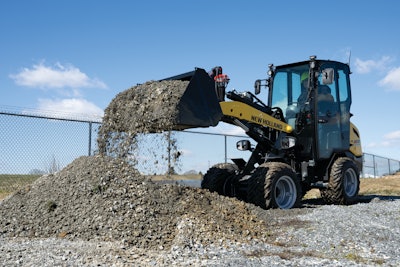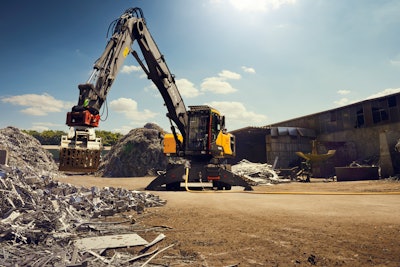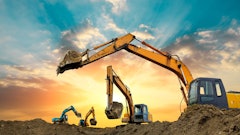
Our industry hesitates to change, especially moving away from diesel internal combustion engines. Diesel gets the work done. Also, diesel engine manufacturers are working to improve the efficiency of and decrease the emissions from diesel engines. While these improvements to diesel engines are important to decrease emissions today, the Environmental Protection Agency’s emission regulations are forcing the issue for contractors who must reduce their carbon footprint moving into the future.
What factors can help you make the transition? How will our industry move forward, and what power sources are ideal for your equipment and applications?
Optimized Diesel Engines & Biodiesel
Any reduction in emissions that can be made today is a viable option. We will not just flip a switch and move all existing and new equipment to a zero-emission fuel. Diesel will be an option for years. However, looking at different engines for your equipment can help decrease your company’s carbon output immediately.
“Diesel engine technology has advanced significantly with emissions reductions, optimized engine componentry, combustion technology improvements and improved low-carbon renewable fuels,” Joel Honeyman, vice president of global innovation, Doosan Bobcat, said. “What is particularly exciting about diesel engine advancements is we expect to see continued investments and improvements with this technology.”
Daniel Kakareka, product portfolio manager – construction products for New Holland Construction, agrees that optimized diesel power remains a short-term answer. “While not as environmentally friendly as the electric or hydrogen power sources, advancements in diesel engine technology continue to improve fuel efficiency and emissions performance. Features like selective catalytic reduction and diesel particulate filters help reduce nitrogen oxide and particulate matter emissions, meeting increasingly stringent regulatory standards.”
 Battery advancements are making electric options more viable, likely leading to more electric excavators, loaders and other machinery hitting the market soon.New Holland Construction
Battery advancements are making electric options more viable, likely leading to more electric excavators, loaders and other machinery hitting the market soon.New Holland Construction
“The high power and torque capabilities mean that they can be used to replace engines of higher displacement, improving efficiency and reducing overall running costs without impacting productivity,” Jeremy Harsin, off-highway marketing director – EBU – for Cummins said. “[They require] less fuel, less servicing with lower emissions with more reliability and more capability. Operators of these engines can also adopt [HVO] as a drop-in substitute for traditional diesel fuel.”
Electric: Short-Term for Small to Mid-Size Equipment
For small and mid-size machines, battery-electric power has a foothold. According to Ray Gallant, for Volvo Construction Equipment North America (Volvo CE) “in the short-term … I think all the focus right now is on batteries and electrification.”
“Batteries and related component costs are dropping while charging times are increasing and will provide more options to customers in the future,” Honeyman said.
This decrease makes battery-electric equipment more cost-effective. The decreased maintenance for battery-electric equipment also reduces the total cost of ownership of these machines.
“We have [many] grid-connected machines and applications that are starting to appear on the market or starting to be more prolific on the market. We've had grid-connected machines for years, but they've been restricted to very few applications. Now you're starting to see them going [into] more … applications out there.”
 Grid-connected equipment is popular in the E.U. and on its way to North America.Volvo CE
Grid-connected equipment is popular in the E.U. and on its way to North America.Volvo CE
He added that these machines can have a battery if the contractors need that option. The equipment can even combine a grid connection and diesel as power sources, offering hybrid flexibility.
A grid-connected asset must be primarily stationary with the current technology, for example, an excavator performing material handling. However, Volvo is looking at options for overhead wire or track along the ground.
Hydrogen & Biodiesels
With larger equipment, electric power is likely not the ideal solution. Because of this, manufacturers are designing drivetrains that use hydrogen and other fuels that produce zero or markedly fewer emissions.
“We are working on new engine projects focused on hydrogen, methanol and other non-diesel fuels to support our customers,” Paul Muller, senior engineering manager for Caterpillar Industrial Power Systems, said.
JCB is all-in on hydrogen combustion engines.
“Research that JCB has done in England has found that battery electric systems work well in excavators up to 4 tons or 5 tons, but for machines bigger than that, batteries are too expensive, too impractical or too heavy,” Lee Tice, JCB product manager, said. “To power heavier equipment, JCB is developing hydrogen engines and has built and tested a hydrogen-powered backhoe and telehandler.”
Other engine manufacturers, including Cummins and Caterpillar Industrial Power Systems, have engines that can be specified to burn several alternative fuels, including hydrogen, HVO, methanol and other biodiesels
Moving Forward
With any new fuel, the priority will be building the infrastructure to support contractors wherever their sites are. The diesel infrastructure has existed for decades. Planning for the delivery of these new power sources must occur as the technology is being implemented by manufacturers and used by contractors.
“The technologies aren't all mature yet,” Gallant said. “We have a lot of work to do, so it's not reasonable to expect everybody to jump to the end state today.”
Another priority is getting buy-in from the operators doing the work. Your team must want to use the equipment, feel safe and know that they will have the power and functionality they are used to.
“As the industry evolves, electric and alternative fueled machines will need to coexist alongside today’s diesel-powered machines as diesel power [will likely continue as] the predominant power source, although some may switch from fossil-based fuels to using increased usage of renewable diesel,” Muller said.





























